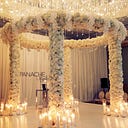Floral Design’s Six Fundamental Principles
Balance, dominance, contrast, rhythm, proportion, and size are the six floral design concepts. These design elements are vital for generating an arrangement that is both agreeable and visually attractive.
Because it generates a feeling of three-dimensional stability, balance is an essential design component. This may be accomplished by arranging items in a symmetrical or asymmetrical pattern.
The floral design relies heavily on balance. It might be formal (symmetrical) or casual (asymmetrical). (asymmetrical).
Another crucial part of balance is proportion. Your floral arrangement will look more stable if it is in proportion to its surroundings and container.
Harmony is another important feature of flower design. This is accomplished when all design aspects operate together and are appropriate for the design.
A compositional method that provides a nice visual impression by arranging identical flowers on each side of an imaginary vertical axis called symmetrical balance. It is often utilized in op art and may be used to represent a concept or feeling in a piece of artwork subtly or dynamically.
Contrast may be utilized to make a design stand out and grab the viewer’s attention. It may be made by utilizing varied colors, forms, sizes, and textures of flowers and vegetation.
It may also be used to contrast the primary flower or flower arrangement with the surrounding vegetation.
Another technique to employ contrast is to group two dissimilar design components to highlight their differences. This is an essential flower-arranging strategy since it helps you pinpoint the main point of your design.
Dominance is the capacity to make a certain design feature stand out. This may be accomplished by the use of a dominating plant material, an accentuated design, a theme, or a focal point.
The prominent design components should not be overpowering and detract from the rest of the floral arrangement; this is referred to as balance.
By incorporating sharply contrasting components in size, color, or texture into a design, contrast may be used to establish dominance. Visual dominance may also be achieved by encircling an element with arrows that point to it.
The importance of uniformity in floral design cannot be overstated. This may be accomplished by the use of similar colors and forms, as well as repetition and rhythm.
It may also be done with several floral shapes such as crescents, triangles, ovals, and spheres.
This is a crucial part of flower design since it permits the arrangement to retain a uniform appearance throughout.
It is also possible to produce unity by using other forms such as curved lines, spirals, or zigzags. This may give a flower arrangement a dynamic and vibrant appearance.
The use of patterns in floral design is a critical component in creating attractive arrangements. This might vary from element symmetry and alignment to element placement and size within an arrangement.
Patterns are repeated compositions of line, shape, color, and texture that draw the attention of the spectator. They may also be utilized to create a focal point in a design.
Scale is another essential aspect of floral design that focuses on the quantitative relationship between one section of an arrangement and another. Scale is produced through contrasting aspects that range from little to large, bright to dark, hard to soft, thick to thin, straight to curving, and everything in between.
The physical and visual texture of flowers, leaves, containers, and other materials all contribute significantly to their overall impression. A coarse and hairy protea will seem considerably different from a smooth calla lily. (see Figure 7–5).
Texture may also be utilized to differentiate between components. Sticks, bird nests, and dried plant materials with various textures may give an unexpected layer to your creations.
Leafy foliage, such as ivy or Italian rescues, may provide a subtle texture to your floral arrangement, highlighting the chosen focal point. Ferns also provide a nice textural contrast.
